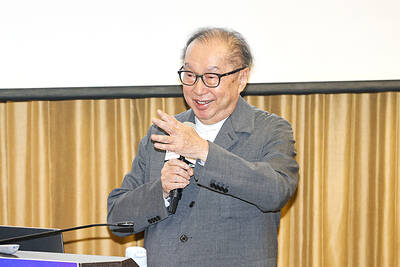Unimicron Technology Corp (欣興電子) yesterday said that its factory utilization rate is expected to climb to more than 85 percent in the second quarter due to recovering production in China and robust demand for IC substrates used in 5G-related applications.
About 80 to 90 percent of its staff in China have returned to work, the Taoyuan-based printed circuit board maker (PCB) said.
Its factory utilization rate plunged to 60 to 75 percent this quarter, as employees in China could not work due to the lockdowns imposed in a bid to contain the spread of COVID-19, it said.
Unimicron said it expects to be adversely affected by the outbreak in the first quarter, as China is its manufacturing hub, contributing up to 35 percent of its total output.
Most of its traditional PCBs, all of its flexible PCBs and 30 percent of its high-density interconnect (HDI) PCBs are produced in China, it said.
It said it expects capacity utilization for IC substrates to remain full through the second quarter, supported primarily by strong demand from the 5G-enabled artificial intelligence, Internet of Things, data center and networking equipment sectors.
“The equipment loading rate for IC substrate capacity will remain at a high level based on customer orders and demand projections,” Unimicron spokesman Michael Shen (沈再生) said.
“Some customers have even placed orders for third-quarter [delivery]. The coronavirus has not affected demand for IC substrates yet,” Shen said.
Unimicron has raised its capital expenditure this year to NT$24.07 billion (US$795.7 million) from NT$11 billion last year.
Most of the funds would be invested in expanding capacity at its plant in Taoyuan’s Yangmei District (楊梅) by 10 to 15 percent for advanced IC substrates used in central processing units and graphics processing units, it said.
The expansion would be used for a single customer’s projects and would not be affected by the pandemic, it said.
The new capacity is expected to be fully utilized by the second half of 2024, it added.
Last quarter, IC substrates were its largest revenue source, contributing about 42 percent to total revenue of NT$22.57 billion, while HDI PCBs — which are suitable for premium smartphones and 5G applications — accounted for 40 percent of revenue, Unimicron said.
Net profit soared 90.64 percent last year to NT$3.26 billion, up from NT$1.71 billion in 2018 — the most in seven years — while earnings per share jumped to NT$2.24 from NT$1.15.
Gross margin last year improved to 13.7 percent from 11.1 percent a year earlier.
The company’s board of directors has approved a proposal to distribute a cash dividend of NT$1.1 per share, representing a payout ratio of 49.1 percent.

BYPASSING CHINA TARIFFS: In the first five months of this year, Foxconn sent US$4.4bn of iPhones to the US from India, compared with US$3.7bn in the whole of last year Nearly all the iPhones exported by Foxconn Technology Group (富士康科技集團) from India went to the US between March and last month, customs data showed, far above last year’s average of 50 percent and a clear sign of Apple Inc’s efforts to bypass high US tariffs imposed on China. The numbers, being reported by Reuters for the first time, show that Apple has realigned its India exports to almost exclusively serve the US market, when previously the devices were more widely distributed to nations including the Netherlands and the Czech Republic. During March to last month, Foxconn, known as Hon Hai Precision Industry

Taiwan Semiconductor Manufacturing Co (TSMC, 台積電) and the University of Tokyo (UTokyo) yesterday announced the launch of the TSMC-UTokyo Lab to promote advanced semiconductor research, education and talent development. The lab is TSMC’s first laboratory collaboration with a university outside Taiwan, the company said in a statement. The lab would leverage “the extensive knowledge, experience, and creativity” of both institutions, the company said. It is located in the Asano Section of UTokyo’s Hongo, Tokyo, campus and would be managed by UTokyo faculty, guided by directors from UTokyo and TSMC, the company said. TSMC began working with UTokyo in 2019, resulting in 21 research projects,

Ashton Hall’s morning routine involves dunking his head in iced Saratoga Spring Water. For the company that sells the bottled water — Hall’s brand of choice for drinking, brushing his teeth and submerging himself — that is fantastic news. “We’re so thankful to this incredible fitness influencer called Ashton Hall,” Saratoga owner Primo Brands Corp’s CEO Robbert Rietbroek said on an earnings call after Hall’s morning routine video went viral. “He really helped put our brand on the map.” Primo Brands, which was not affiliated with Hall when he made his video, is among the increasing number of companies benefiting from influencer

Quanta Computer Inc (廣達) chairman Barry Lam (林百里) yesterday expressed a downbeat view about the prospects of humanoid robots, given high manufacturing costs and a lack of target customers. Despite rising demand and high expectations for humanoid robots, high research-and-development costs and uncertain profitability remain major concerns, Lam told reporters following the company’s annual shareholders’ meeting in Taoyuan. “Since it seems a bit unworthy to use such high-cost robots to do household chores, I believe robots designed for specific purposes would be more valuable and present a better business opportunity,” Lam said Instead of investing in humanoid robots, Quanta has opted to invest